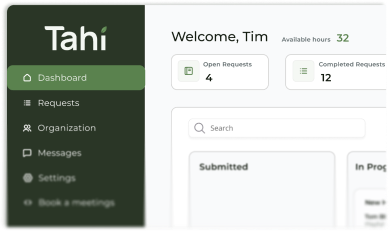Conversion Rate Optimisation (CRO)
Conversion Rate Optimisation is the systematic process of increasing the percentage of website visitors who take a desired action, like making a purchase.
What are some simple CRO techniques for a Webflow website?
Getting started with CRO doesn't have to be complicated, especially with a platform as flexible as Webflow. A great starting point is to focus on clarity and trust. Make sure your call-to-action (CTA) buttons are impossible to miss and use clear, action-oriented text like 'Get Started Today' instead of a vague 'Submit'. Simplifying your forms can also make a huge difference. Only ask for the information you absolutely need. The fewer fields someone has to fill in, the more likely they are to complete the form.
Another effective technique is adding social proof. This could be in the form of customer testimonials, case studies, or logos of companies you've worked with. This builds trust and reassures visitors that they're making a good decision. Finally, take a hard look at your hero section. Your headline should clearly state the value you offer in a way that resonates with your ideal customer. Small, iterative changes in these areas can lead to significant improvements in your conversion rates.
How does user experience design impact my website's conversion rates?
User experience design is the foundation of good conversion rates. Think of it this way, if your website is confusing, slow, or difficult to navigate, visitors will simply leave. A positive user experience, on the other hand, builds trust and makes it easy for people to find what they're looking for and take the action you want them to take.
A well-designed UX guides the user on a clear path from their arrival to the conversion point. It removes friction by anticipating their needs, providing clear information, and ensuring every interaction is intuitive. This involves everything from a logical site structure and readable typography to a mobile-friendly layout. When users feel understood and respected, they are far more likely to trust your brand and convert. A thoughtful user interface (UI), as we discuss in our post about The Calm UI, supports this by creating a sense of trust rather than using tricks to get a click.
What is a good conversion rate for a SaaS marketing website?
This is a common question, but the answer isn't a single magic number. Industry benchmarks often suggest an average conversion rate for SaaS websites is somewhere between 2% and 5%. However, this can vary wildly depending on your industry, price point, traffic source, and the specific action you're measuring. For instance, converting a visitor to a free trial will naturally have a higher rate than converting them to a high-ticket annual plan.
Instead of fixating on a universal benchmark, it’s more productive to focus on your own baseline and aim for continuous improvement. The goal of CRO is to steadily increase your own conversion rate over time through testing and optimisation. For more insights on this, you can read our guide on building a SaaS marketing site that actually converts. The key is to understand your own numbers and use them as the benchmark for growth.
How much can improving page speed increase my website's sales?
The impact of page speed on conversions is significant and well-documented. A faster website directly translates to a better user experience, which keeps potential customers engaged. Studies have shown that even a one-second delay in page load time can result in a notable drop in conversions. People are impatient online, and a slow site can lead to frustration and a high bounce rate, meaning visitors leave before they even see your offer.
By improving your website's performance, you reduce the chances of a potential customer leaving. A faster site feels more professional and trustworthy, which can directly influence a visitor's decision to make a purchase, sign up, or fill out a form. Google also prioritises faster websites in its search rankings, meaning better page speed optimisation can lead to more organic traffic. It's a win-win situation that boosts both user satisfaction and your bottom line, and as we discuss in our sustainability article, it's better for the planet too.
How can I get started with CRO without a big budget?
Starting with Conversion Rate Optimisation doesn't require a massive budget. The most important thing is to adopt a mindset of continuous, data-informed improvement. Begin by using free tools like Google Analytics to understand how users are behaving on your site. Look for pages with high drop-off rates or forms that aren't being completed. This data will give you clues about where to focus your efforts.
Another low-cost method is to simply talk to your customers. Ask them for feedback on your website. You can also implement simple A/B tests on headlines, button colours, or images to see what resonates most with your audience. Making small, incremental changes based on this feedback and data is the core of effective CRO.
As you grow, you might find that having an expert partner can help you spot opportunities you might have missed. Our flexible subscription plans are designed to provide that expertise without locking you into a large, expensive project. If you're not sure where to start, we offer a free, no-obligation site audit to give you actionable insights you can use right away. It's a great first step to turning more of your visitors into valuable customers.







